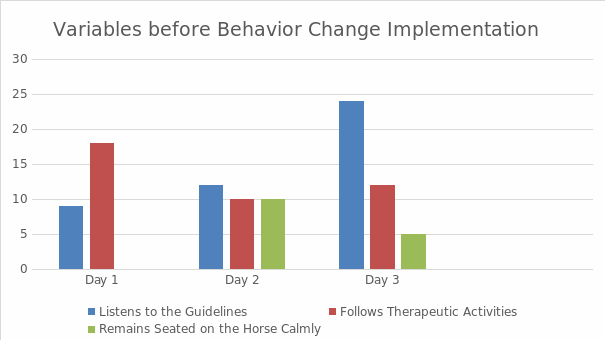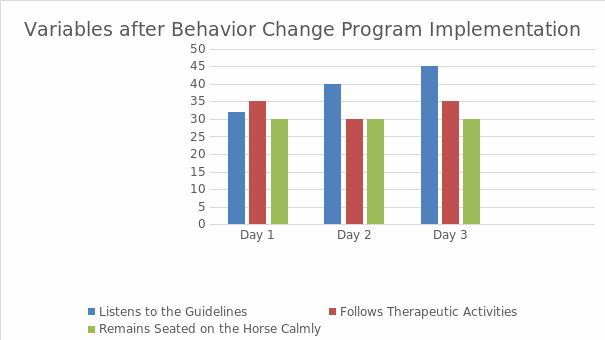It may be challenging to work with children, and some factors can worsen the situation. According to researchers, behavioural disorder entails “a pattern of disruptive behaviours in a child that manifests for at least six months leading to problems in the social set-ups including in school, and at home” (“Behavioural disorders,” 2017, para. 1). The common disorders among children include Attention Deficit Hyperactivity Disorder (ADHD), which potentially involves impulsivity, defiant behaviour, drug use, inattention, and hyperactivity. This Applied Behaviour Analysis paper describes a hypothetical project meant to provide an opportunity to sharpen skills of observation and management of children by devising an intervention plan aimed at improving a particular child’s behaviour.
Identified Student
As a therapeutic horse-riding instructor for disabled children, I sometimes have to face various patterns of behaviour that make me curious and willing to help. Moreover, my profession requires me to have full insight regarding the factors that hinder horse riding learning and the overall wellbeing of the learners. For example, recently, I started working with Jake, who is twelve, and his behaviour attracted my attention. During the riding sessions, he has difficulty with listening to my guidelines, following the instructions in Therapeutic activities, and sitting still on the horse. Jake demonstrates excessive talking and physical movement, as well as an almost total disability to concentrate and organize his activities. According to Benzing, Chang, and Schmidt (2018), it is possible to suggest that this child exhibits a behavioural problem, attributed to Attention Deficit Hyperactivity Disorder (ADHD) due to the inattentive and hyperactive-impulsive symptoms.
Background Information
Curiosity concerning this issue prompted me to seek pertinent background information regarding Jake and his surrounding community. A scheduled home visit provided me with a great platform to gather relevant health data from the father that could trigger the behaviour problem. From the past medical history, it was reported that Jake suffered from sleep apnoea and binge eating. Pertinent information from social history indicated that his parents divorced because the mother was an alcoholic. What is more, Jake’s father reported that his son was hyperactive, his room was always disorganized, and he rarely completed his homework.
Target Behaviours to Facilitate Measurement of Occurrence of the Behaviour
Clinicians and psychologists use data from applied behaviour analysis to understand the function of behaviours and create hypotheses. Therefore, defining target responses will assist in the evaluation of how often they manifest. Some of the target behaviours include the ability to listen to the guidelines, following all Therapeutic activities, and remaining seated on the horse calmly.
Data Collection System
Data collection systems are essential for healthcare providers, and therapists in devising viable behavioural support strategies. Among the considerable number of available ABA data collection systems, Frequency/Event and Rate Recording best suit the project (Horner & Sugai, 2015). The system will provide the best measurement of Jake’s rate of occurrence of target behaviour because the interaction with riders often occurs for limited periods during sessions.
First Data Collection Sheets
Table 1. Frequency (within Horse Riding Sessions of Sixty Minutes)

Hypothesis
Increasing the appropriate behaviours and decreasing problem behaviour using the Applied Behaviour Analysis (ABA) will significantly improve the inattentive and hyper-impulsive symptoms exhibited in the case scenario.
Behavioural Objectives
In light of the trend observed in Jake’s conduct, developing objectives towards realizing appropriate action and minimizing inappropriate behaviour is essential.
Objectives to Increase Appropriate Behaviour
- By the end of one week, Jake will stay seated on the horse calmly for at least thirty minutes.
- By the end of one week, Jake should be able to remain attentive and follow the guidelines for at least thirty minutes.
Objectives to Decrease Inappropriate Behaviour
- By the end of one week, Jake will reduce the episodes of unnecessary and excessive physical movements from twelve to four.
- By the end of one week, other children who attend sessions should report Jake having reduced the excessive talking.
Developing a Positive Behaviour Change Program
Basing on the outlined behavioural objectives, it is possible to create a complementary behaviour change program. In its entirety, it will include behavioural modification by implementing family therapy with a psychologist combined with brief yoga and acute physical activity sessions (Molina & Musich, 2016). When focusing on the presented case scenario, the long-term program includes a multi-disciplinary collaboration towards realizing the desired behaviour for the boy.
First of all, Jake will undergo psychotherapy sessions twice a week with the psychologist and sometimes in the presence of his father. Consequently, psychotherapy will potentially improve self-worth and self-esteem. Further, meditations through yoga classes are proved to have a positive impact on children’s mental and physical health (Evans et al., 2018). Among other things, “acute physical activity of moderate to vigorous intensity has been shown to improve cognitive functions in children” (Benzing et al., 2018, p. 1). That is why a yoga session and physical activity sessions (twice a week total) will improve Jake’s ability to stay calm, concentrate and be attentive. These practices will also let the boy get rid of extra energy and focus on following the guidelines.
Second Data Collection and Graphing
Table 1. Frequency (within Horse Riding Sessions of Sixty Minutes)

Results Analysis
Table 3. Average Time Taken by Jake before and after the Implementation of the Behaviour Change Program
The implementation of the behaviour change program through the ABA approach provides a significant improvement in the desired positive conduct. After a week of performing special strategies and activities including yoga and physical activity classes and sessions with a psychologist, Jake started portraying appropriate behaviour at horse riding lessons. Finally, since the boy demonstrated the ability to stay seated on the horse calmly and follow the guidelines for more than thirty minutes during a lesson, it is possible to mention that the objectives to increase appropriate behaviour are realized.
Brief Summary of Intervention
Attention deficit hyperactivity disorder (ADHD) affects individuals on how they pay attention, sit and tend to behave, commonly occurring in children and teens (“Behavioural disorders,” 2017). To help kids manage their ADHD symptoms, resorting to psychotherapy, yoga and physical activity sessions is crucial. My intervention predominantly relied on sessions with a psychologist and meditations so that Jake would learn to handle his emotions and improve his self-esteem. Yoga practices and extra physical activity taught him how to replace negative behaviours with positive ones.
References
Behavioural disorders. (2017).
Benzing, V., Chang, Y. K., & Schmidt, M. (2018). Acute physical activity enhances executive functions in children with ADHD. Scientific Reports, 8(1), 1-10.
Evans, S., Ling, M., Hill, B., Rinehart, N., Austin, D., & Sciberras, E. (2018). Systematic review of meditation-based interventions for children with ADHD. European Child & Adolescent Psychiatry, 27(1), 9-27.
Horner, R. H., & Sugai, G. (2015). School-wide PBIS: An example of applied behaviour analysis implemented at a scale of social importance. Behaviour Analysis in Practice, 8(1), 80-85.
Molina, M. F., & Musich, F. M. (2016). Perception of parenting style by children with ADHD and its relation with inattention, hyperactivity/impulsivity and externalizing symptoms. Journal of Child and Family Studies, 25(5), 1656-1671.
